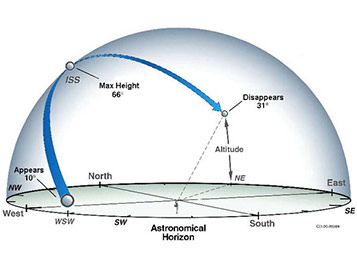(Note:When you sign up make sure you explore the site some and look at the example. This is all excellently explained on the NASA site-I offer my personal experience with the hope that it makes it easier. I've spotted the ISS 11 times to date.)
The emails will look something like this:
Time: Sun Apr 06 7:58 PM, Visible: 6 min, Max Height: 78 degrees, Appears: SW, Disappears: NE
So what does this mean?
TIME: Simple enough. It is your local time so you don't have to convert from UTC GMT or EST. It's best to find a place with low light pollution. I go to the beach because most of the sky is dark. I've spotted it no problem in the street light polluted playground behind my apartment building. I've even caught it out my bedroom window when the pass was in that area of the sky. Get there early and relax. It's always on time. Usually right after sunset or right before sunrise.
VISIBLE: This is the duration of the pass that you will be in the right place to catch the reflection. The shortest I've seen were 3 min. The longest average around 6 min.
MAX HEIGHT: There is a cool diagram on the NASA site.
On the longer passes this number basically represents how directly overhead it will pass.
APPEARS/DISAPPEARS: You don't have to be looking precisely in these directions so a compass isn't necessary.
You will see a star that is moving fast and at first you might think it's an airplane but the speed will be much faster than any plane you've seen and it won't twinkle.
Here's a simulation I animated in Flash. It gives you an idea of the speed of the ISS.

